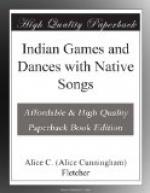For example: the Indian noted the unfailing recurrence of day and night and that upon the regularity with which one followed the other all creatures relied, while man depended upon this constancy to carry out any given purpose. From thoughts upon this natural phenomenon and its effects on the actions of men, ideas arose that led the Indian to the conception of truth, that something, as between man and man, that can be depended on both in word and in deed. “Thus,” the old men said, “Wakon’da taught us the necessity of truthfulness, if we would live peacefully together.” Other natural aspects, as the storm, with its terrifying thunder and destructive lightning, and the passing of the clouds revealing the blue sky, when the birds renewed their song, seemed to picture to the Indian the devastation of war and the happiness of peace. Again, the tree, compacted of many parts, suggested how the tribe could be made to stand and become strong.
So it came to pass that as the ancient people looked about and thought on what they saw, they gradually formulated ceremonies and adopted symbols in order to express what they came to believe. All their rites, their vocations, their pleasures were born, practiced and enjoyed under the arching skies, and were permeated, as by a vital spirit, with an unquestioning consciousness of oneness with nature.
We shall not be false to any great truths that have been revealed to us concerning the world in which we live, if we listen to the olden voice, an unseen heritage of our bounteous land, as it sings of man’s unity with nature. May they who join in these dances and games catch their vital spirit and learn to feel at home with the winds, the clouds, the fields and the woods.
SONG AND DANCE AMONG THE INDIANS
THE SONG
While studying Indian life and thought through the sharing, as far as possible, of native conditions, I discovered Indian music. In the loneliness that naturally belonged to my circumstances this discovery was like finding a flower hidden in a tangle hard to penetrate. I had heard Indians “singing,” but the noise of the drum, the singers’ stress of voice, so overlaid the little song that its very existence was not even suspected. Circumstances at length arose, incident to my convalescence after a long illness, when, to give me pleasure, my Indian friends came and sang softly to me, without the drum. Great was my surprise to hear music; to be told that I was listening to the same songs that the earnest men and women had previously sung but which for me had been buried under a tumultuous din. Thenceforth my ears were opened and never again, no matter how confusing the conditions, did I fail to catch the hidden melody. As my appreciation of the value of Indian music grew, I determined to gather and to preserve these wild flowers of song. I wanted them not merely as a contribution to the study of music but that they might help to vibrate the chords that belong to a common humanity.




